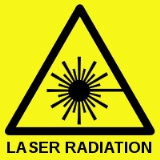
Timeline of Polish science and technology
Encyclopedia
Education has been of prime interest to Poland's rulers since the early 12th century. The catalog of the library of the Cathedral Chapter in Kraków
dating from 1110 shows that Polish scholars already then had access to western European literature. In 1364, King Kazimierz the Great
founded the Cracow Academy, which would become one of the great universities of Europe. The list of famous scientists in Poland begins in earnest with the polymath
Nicolaus Copernicus
, who studied there.
In 1773 King Stanisław August Poniatowski established the Commission of National Education
, the world's first ministry of education.
After the third partition of Poland
, in 1795, no Polish state existed. The 19th and 20th centuries saw many Polish scientists working abroad. The greatest was Maria Skłodowska-Curie, a physicist and chemist living in France. Another noteworthy one was Ignacy Domeyko
, a geologist and mineralogist who worked in Chile.
In the first half of the 20th century, Poland was a flourishing center of mathematics. Outstanding Polish mathematicians formed the Lwów School of Mathematics
(with Stefan Banach
, Hugo Steinhaus
, Stanisław Ulam) and Warsaw School of Mathematics
(with Alfred Tarski
, Kazimierz Kuratowski
, Wacław Sierpiński). The events of World War II
pushed many of them into exile. Such was the case of Benoît Mandelbrot
, whose family left Poland when he was still a child. An alumnus of the Warsaw School of Mathematics was Antoni Zygmund
, one of the shapers of 20th-century mathematical analysis
.
Today Poland has over 100 institutions of post-secondary education — technical, medical, economic, as well as 500 universities — which are located in most major cities such as Gdańsk
, Kraków
, Lublin
, Poznań
, Rzeszów
and Warsaw
. They employ over 61,000 scientists and scholars. Another 300 research and development institutes are home to some 10,000 researchers. There are, in addition, a number of smaller laboratories. All together, these institutions support some 91,000 scientists and scholars.
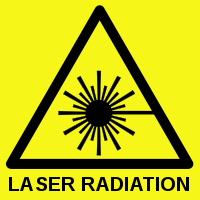

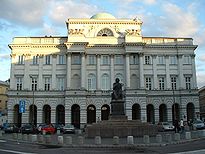


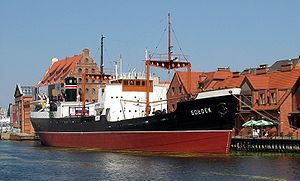
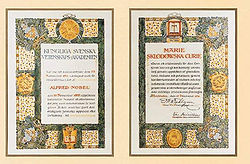
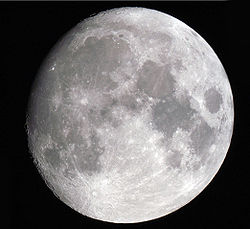
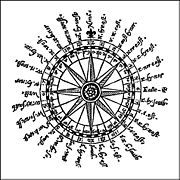

Kraków
Kraków also Krakow, or Cracow , is the second largest and one of the oldest cities in Poland. Situated on the Vistula River in the Lesser Poland region, the city dates back to the 7th century. Kraków has traditionally been one of the leading centres of Polish academic, cultural, and artistic life...
dating from 1110 shows that Polish scholars already then had access to western European literature. In 1364, King Kazimierz the Great
Casimir III of Poland
Casimir III the Great , last King of Poland from the Piast dynasty , was the son of King Władysław I the Elbow-high and Hedwig of Kalisz.-Biography:...
founded the Cracow Academy, which would become one of the great universities of Europe. The list of famous scientists in Poland begins in earnest with the polymath
Polymath
A polymath is a person whose expertise spans a significant number of different subject areas. In less formal terms, a polymath may simply be someone who is very knowledgeable...
Nicolaus Copernicus
Nicolaus Copernicus
Nicolaus Copernicus was a Renaissance astronomer and the first person to formulate a comprehensive heliocentric cosmology which displaced the Earth from the center of the universe....
, who studied there.
In 1773 King Stanisław August Poniatowski established the Commission of National Education
Komisja Edukacji Narodowej
The Commission of National Education was the central educational authority in the Polish-Lithuanian Commonwealth, created by the Sejm and king Stanisław August Poniatowski on October 14, 1773...
, the world's first ministry of education.
After the third partition of Poland
Partitions of Poland
The Partitions of Poland or Partitions of the Polish–Lithuanian Commonwealth took place in the second half of the 18th century and ended the existence of the Polish–Lithuanian Commonwealth, resulting in the elimination of sovereign Poland for 123 years...
, in 1795, no Polish state existed. The 19th and 20th centuries saw many Polish scientists working abroad. The greatest was Maria Skłodowska-Curie, a physicist and chemist living in France. Another noteworthy one was Ignacy Domeyko
Ignacy Domeyko
Ignacy Domeyko or Domejko was a 19th-century geologist, mineralogist and educator who was born in Nesvizh, Imperial Russia , into a Polish-Lithuanian family...
, a geologist and mineralogist who worked in Chile.
In the first half of the 20th century, Poland was a flourishing center of mathematics. Outstanding Polish mathematicians formed the Lwów School of Mathematics
Lwów School of Mathematics
The Lwów School of Mathematics was a group of mathematicians who worked between the two World Wars in Lviv, then known as Lwów and located in Poland, but now located in western Ukraine. The mathematicians often met at the famous Scottish Café to discuss mathematical problems, and published in the...
(with Stefan Banach
Stefan Banach
Stefan Banach was a Polish mathematician who worked in interwar Poland and in Soviet Ukraine. He is generally considered to have been one of the 20th century's most important and influential mathematicians....
, Hugo Steinhaus
Hugo Steinhaus
Władysław Hugo Dionizy Steinhaus was a Polish mathematician and educator. Steinhaus obtained his PhD under David Hilbert at Göttingen University in 1911 and later became a professor at the University of Lwów, where he helped establish what later became known as the Lwów School of Mathematics...
, Stanisław Ulam) and Warsaw School of Mathematics
Warsaw School of Mathematics
"Warsaw School of Mathematics" is the name given to a group of mathematicians who worked at Warsaw, Poland, in the two decades between the World Wars, especially in the fields of logic, set theory, point-set topology and real analysis. They published in the journal Fundamenta Mathematicae, founded...
(with Alfred Tarski
Alfred Tarski
Alfred Tarski was a Polish logician and mathematician. Educated at the University of Warsaw and a member of the Lwow-Warsaw School of Logic and the Warsaw School of Mathematics and philosophy, he emigrated to the USA in 1939, and taught and carried out research in mathematics at the University of...
, Kazimierz Kuratowski
Kazimierz Kuratowski
Kazimierz Kuratowski was a Polish mathematician and logician. He was one of the leading representatives of the Warsaw School of Mathematics.-Biography and studies:...
, Wacław Sierpiński). The events of World War II
World War II
World War II, or the Second World War , was a global conflict lasting from 1939 to 1945, involving most of the world's nations—including all of the great powers—eventually forming two opposing military alliances: the Allies and the Axis...
pushed many of them into exile. Such was the case of Benoît Mandelbrot
Benoît Mandelbrot
Benoît B. Mandelbrot was a French American mathematician. Born in Poland, he moved to France with his family when he was a child...
, whose family left Poland when he was still a child. An alumnus of the Warsaw School of Mathematics was Antoni Zygmund
Antoni Zygmund
Antoni Zygmund was a Polish-born American mathematician.-Life:Born in Warsaw, Zygmund obtained his PhD from Warsaw University and became a professor at Stefan Batory University at Wilno...
, one of the shapers of 20th-century mathematical analysis
Mathematical analysis
Mathematical analysis, which mathematicians refer to simply as analysis, has its beginnings in the rigorous formulation of infinitesimal calculus. It is a branch of pure mathematics that includes the theories of differentiation, integration and measure, limits, infinite series, and analytic functions...
.
Today Poland has over 100 institutions of post-secondary education — technical, medical, economic, as well as 500 universities — which are located in most major cities such as Gdańsk
Gdansk
Gdańsk is a Polish city on the Baltic coast, at the centre of the country's fourth-largest metropolitan area.The city lies on the southern edge of Gdańsk Bay , in a conurbation with the city of Gdynia, spa town of Sopot, and suburban communities, which together form a metropolitan area called the...
, Kraków
Kraków
Kraków also Krakow, or Cracow , is the second largest and one of the oldest cities in Poland. Situated on the Vistula River in the Lesser Poland region, the city dates back to the 7th century. Kraków has traditionally been one of the leading centres of Polish academic, cultural, and artistic life...
, Lublin
Lublin
Lublin is the ninth largest city in Poland. It is the capital of Lublin Voivodeship with a population of 350,392 . Lublin is also the largest Polish city east of the Vistula river...
, Poznań
Poznan
Poznań is a city on the Warta river in west-central Poland, with a population of 556,022 in June 2009. It is among the oldest cities in Poland, and was one of the most important centres in the early Polish state, whose first rulers were buried at Poznań's cathedral. It is sometimes claimed to be...
, Rzeszów
Rzeszów
Rzeszów is a city in southeastern Poland with a population of 179,455 in 2010. It is located on both sides of the Wisłok River, in the heartland of the Sandomierska Valley...
and Warsaw
Warsaw
Warsaw is the capital and largest city of Poland. It is located on the Vistula River, roughly from the Baltic Sea and from the Carpathian Mountains. Its population in 2010 was estimated at 1,716,855 residents with a greater metropolitan area of 2,631,902 residents, making Warsaw the 10th most...
. They employ over 61,000 scientists and scholars. Another 300 research and development institutes are home to some 10,000 researchers. There are, in addition, a number of smaller laboratories. All together, these institutions support some 91,000 scientists and scholars.
1951 - the present



- Blue laser - first blue laser in Poland (third in the world)
- Artificial heartArtificial heartAn artificial heart is a mechanical device that replaces the heart. Artificial hearts are typically used in order to bridge the time to heart transplantation, or to permanently replace the heart in case transplantation is impossible...
- an implant, program: "Polish Artificial Heart"
- PSR 1257+12 - a pulsar located 2,630 light years from Earth. It is believed to be orbited by at least four planets. These were the first extrasolar planets ever discovered (by a Polish astronomerAstronomerAn astronomer is a scientist who studies celestial bodies such as planets, stars and galaxies.Historically, astronomy was more concerned with the classification and description of phenomena in the sky, while astrophysics attempted to explain these phenomena and the differences between them using...
, Aleksander WolszczanAleksander WolszczanAleksander Wolszczan is a Polish astronomer. He is the co-discoverer of the first extrasolar planets and pulsar planets.- Scientific career :...
, in 1992). Polish astronomy has traditionally been among the best in the world.
- Foundation For Polish ScienceFoundation For Polish ScienceThe Foundation For Polish Science is an independent, non-profit making organisation. Established in 1991, the Foundation's mission is to provide assistance and support to the scientific community in Poland...
- since (1991)
- PZL W-3 Sokół - a helicopter, FAA certificate in (1989)
- PZL KaniaPZL Kania-References:* Taylor, John W R . Jane's All The World's Aircraft 1982-83. London:Jane's Yearbooks, 1982. ISBN 0 7106-0748-2.* Taylor, John W R . Jane's All The World's Aircraft 1988-89. Coulsdon, UK:Jane's Defence Data, 1988. ISBN 0 7106-0867-5....
- a helicopter, first prototype (1979), FAR-29 certificate (early 1980s)
- Odra (computer)Odra (computer)Odra was a line of computers manufactured in Wrocław, Poland.The production started in 1959–1960. Models 1001, 1002, 1003, 1013, 1103, 1204 were of original Polish construction. Models 1304 and 1305 were functional counterparts of ICL 1905 and 1906 due to software agreement...
- a line of computers manufactured in Wrocław (1959/1960)
- K-202K-202K-202 was a 16-bit minicomputer, invented by Polish scientist Jacek Karpiński between 1971-1973 in cooperation with British companies Data-Loop and M.B. Metals. Approximately 30 units were produced. The later production was halted as it was not in line with the ES EVM causing the inventor to...
- first Polish microcomputer invented by Jacek KarpińskiJacek KarpinskiJacek Karpiński was a Polish pioneer in computer engineering and computer science.During WW2 he was a soldier of Batalion Zośka of Polish Home Army, awarded multiple times with a Cross of Valour...
(1971)
- Polish Polar Station, HornsundPolish Polar Station, HornsundPolish Polar Station, Hornsund is at Isbjørnhamna in Hornsund fjord, on Spitsbergen island in the Norwegian Svalbard archipelago, operated since 1957.-Station:...
- since (1957)
- PZL SW-4 Puszczyk - a Polish light single-engine multipurpose helicopter manufactured by PZL Swidnik
- EP-09 - 'B0B0' Polish electric locomotive class
- PT-91PT-91The PT-91 Twardy is a Polish main battle tank. It is a development of the T-72M1 and first entered service in 1995...
- a Polish main battle tankTankA tank is a tracked, armoured fighting vehicle designed for front-line combat which combines operational mobility, tactical offensive, and defensive capabilities...
. Designed at the Research and Development Centre of Mechanical Systems OBRUM (Ośrodek Badawczo-Rozwojowy Urządzeń Mechanicznych) in GliwiceGliwiceGliwice is a city in Upper Silesia in southern Poland, near Katowice. Gliwice is the west district of the Upper Silesian Metropolitan Union – a metropolis with a population of 2 million...
- Grom (missile)Grom (missile)The Grom is a man-portable air-defense system produced in Poland. It consists of a 72 mm anti-aircraft missile set with a flight speed of 650 m/s, as well as a single-use launcher, re-usable gripstock and thermal battery coolant assembly electric unit...
- an anti-aircraft missile
- 206FM206FMMinehunters 206 FM class were built in former "Komuny Paryskiej" shipyard .- Armament :*underwater vehicle*missile/artillery system*2 SAM launchers***chaff launchers*depth charges -External links:*...
- class minesweeper (NATO: "Krogulec")
- Meteor (rocket)Meteor (rocket)Meteor is a designation of a series of Polish sounding rockets.The Meteor rockets were built between 1963 and 1974.The Meteor 1 and Meteor 2H were single-stage rockets. The Meteor 2K was a two-stage rocket. The Meteor 3 was a two-stage rocket, compound from two Meteor 1 rockets.Meteor rockets...
- a series of sounding rockets (1963)
- PZL TS-11 IskraPZL TS-11 Iskra|-See also:-References:*"Poland's Veteran Spark". Air International, March 1979, Vol 16 No. 3. Bromley, UK:Fine Scroll Publishing. pp. 126–131....
- a jet trainer aircraft, used by the air forces of Poland and India (1960)
- Lim-6 - attack aircraft (1955)
- The Polish Academy of SciencesPolish Academy of SciencesThe Polish Academy of Sciences, headquartered in Warsaw, is one of two Polish institutions having the nature of an academy of sciences.-History:...
, headquartered in WarsawWarsawWarsaw is the capital and largest city of Poland. It is located on the Vistula River, roughly from the Baltic Sea and from the Carpathian Mountains. Its population in 2010 was estimated at 1,716,855 residents with a greater metropolitan area of 2,631,902 residents, making Warsaw the 10th most...
, was founded in 1952.
1901-1950
- Polish mine detectorPolish mine detectorThe Mine detector Mark I was a metal detector for landmines developed during World War II in the winter of 1941–1942 by Polish lieutenant Józef Kosacki.- History :...
was a metal detector used for detecting land mines, developed during World War IIWorld War IIWorld War II, or the Second World War , was a global conflict lasting from 1939 to 1945, involving most of the world's nations—including all of the great powers—eventually forming two opposing military alliances: the Allies and the Axis...
(1941–42) by Polish Lieutenant Józef Stanisław Kozacki. It contributed substantially to British Field Marshal Bernard Montgomery's 1942 victory over German Field Marshal Erwin RommelErwin RommelErwin Johannes Eugen Rommel , popularly known as the Desert Fox , was a German Field Marshal of World War II. He won the respect of both his own troops and the enemies he fought....
at El AlameinEl AlameinEl Alamein is a town in the northern Matrouh Governorate of Egypt. Located on the Mediterranean Sea, it lies west of Alexandria and northwest of Cairo. As of 2007, it has a local population of 7,397 inhabitants.- Climate :...
.
- Cryptologic bombBomba (cryptography)The bomba, or bomba kryptologiczna was a special-purpose machine designed about October 1938 by Polish Cipher Bureau cryptologist Marian Rejewski to break German Enigma-machine ciphers....
was a special-purpose machine designed in 1938 by Polish mathematicianMathematicianA mathematician is a person whose primary area of study is the field of mathematics. Mathematicians are concerned with quantity, structure, space, and change....
-cryptologist Marian RejewskiMarian RejewskiMarian Adam Rejewski was a Polish mathematician and cryptologist who in 1932 solved the plugboard-equipped Enigma machine, the main cipher device used by Germany...
to speed the breaking of the Enigma machineEnigma machineAn Enigma machine is any of a family of related electro-mechanical rotor cipher machines used for the encryption and decryption of secret messages. Enigma was invented by German engineer Arthur Scherbius at the end of World War I...
cipherCipherIn cryptography, a cipher is an algorithm for performing encryption or decryption — a series of well-defined steps that can be followed as a procedure. An alternative, less common term is encipherment. In non-technical usage, a “cipher” is the same thing as a “code”; however, the concepts...
s that would be used by Nazi GermanyNazi GermanyNazi Germany , also known as the Third Reich , but officially called German Reich from 1933 to 1943 and Greater German Reich from 26 June 1943 onward, is the name commonly used to refer to the state of Germany from 1933 to 1945, when it was a totalitarian dictatorship ruled by...
in World War IIWorld War IIWorld War II, or the Second World War , was a global conflict lasting from 1939 to 1945, involving most of the world's nations—including all of the great powers—eventually forming two opposing military alliances: the Allies and the Axis...
. It was a forerunner of the "BombeBombeThe bombe was an electromechanical device used by British cryptologists to help decipher German Enigma-machine-encrypted signals during World War II...
s" that would be used by the British at Bletchley ParkBletchley ParkBletchley Park is an estate located in the town of Bletchley, in Buckinghamshire, England, which currently houses the National Museum of Computing...
, and which would be a major element in the Allied UltraUltraUltra was the designation adopted by British military intelligence in June 1941 for wartime signals intelligence obtained by "breaking" high-level encrypted enemy radio and teleprinter communications at the Government Code and Cypher School at Bletchley Park. "Ultra" eventually became the standard...
program that may have decided the outcome of World War IIWorld War IIWorld War II, or the Second World War , was a global conflict lasting from 1939 to 1945, involving most of the world's nations—including all of the great powers—eventually forming two opposing military alliances: the Allies and the Axis...
.
- Biuro Szyfrów (Cipher Bureau) was the Polish military intelligenceMilitary intelligenceMilitary intelligence is a military discipline that exploits a number of information collection and analysis approaches to provide guidance and direction to commanders in support of their decisions....
agency that made the first break (1932, just as Adolf HitlerAdolf HitlerAdolf Hitler was an Austrian-born German politician and the leader of the National Socialist German Workers Party , commonly referred to as the Nazi Party). He was Chancellor of Germany from 1933 to 1945, and head of state from 1934 to 1945...
was about to take power in Germany) into the German Enigma machineEnigma machineAn Enigma machine is any of a family of related electro-mechanical rotor cipher machines used for the encryption and decryption of secret messages. Enigma was invented by German engineer Arthur Scherbius at the end of World War I...
cipherCipherIn cryptography, a cipher is an algorithm for performing encryption or decryption — a series of well-defined steps that can be followed as a procedure. An alternative, less common term is encipherment. In non-technical usage, a “cipher” is the same thing as a “code”; however, the concepts...
that would be used by Nazi GermanyNazi GermanyNazi Germany , also known as the Third Reich , but officially called German Reich from 1933 to 1943 and Greater German Reich from 26 June 1943 onward, is the name commonly used to refer to the state of Germany from 1933 to 1945, when it was a totalitarian dictatorship ruled by...
through World War IIWorld War IIWorld War II, or the Second World War , was a global conflict lasting from 1939 to 1945, involving most of the world's nations—including all of the great powers—eventually forming two opposing military alliances: the Allies and the Axis...
, and kept reading Enigma ciphers at least until France's capitulationCapitulation (surrender)Capitulation , an agreement in time of war for the surrender to a hostile armed force of a particular body of troops, a town or a territory....
in June 1940.
- Czochralski processCzochralski processThe Czochralski process is a method of crystal growth used to obtain single crystals of semiconductors , metals , salts, and synthetic gemstones...
- a method of crystal growth used to obtain single crystals of semiconductors (e.g. silicon, germanium and gallium arsenide), metals (e.g. palladium, platinum, silver, gold) and salts (1916)
- Vickers Tank Periscope MK.IVVickers Tank Periscope MK.IVThe Vickers Tank Periscope MK.IV, invented by Polish engineer Rudolf Gundlach, was first patented in 1936 as Gundlach Peryskop obrotowy. It was the first device to allow the tank commander to have a 360-degree view from his turret, with a single periscope...
- the first device to allow the tank commander to have a 360-degree view from his turret, invented by engineer Rudolf GundlachRudolf GundlachRudolf Gundlach was a Polish engineer, inventor and tank designer. He headed the design division of the Armored Weapons Development Office .He was the chief designer of the Ursus wz...
(1936)
- Polish notationPolish notationPolish notation, also known as prefix notation, is a form of notation for logic, arithmetic, and algebra. Its distinguishing feature is that it places operators to the left of their operands. If the arity of the operators is fixed, the result is a syntax lacking parentheses or other brackets that...
- also known as prefix notation, is a method of mathematical expression (1920)

- Reverse Polish notationReverse Polish notationReverse Polish notation is a mathematical notation wherein every operator follows all of its operands, in contrast to Polish notation, which puts the operator in the prefix position. It is also known as Postfix notation and is parenthesis-free as long as operator arities are fixed...
- (RPN), also known as postfix notation (1920)
- Zygalski sheets, also known as "perforated sheets" (invented in 1938 by Henryk ZygalskiHenryk ZygalskiHenryk Zygalski was a Polish mathematician and cryptologist who worked at breaking German Enigma ciphers before and during World War II.-Life:...
), were one of a number of devices created by the Polish Cipher Bureau to facilitate the breaking of German Enigma ciphers.
- Stefan BanachStefan BanachStefan Banach was a Polish mathematician who worked in interwar Poland and in Soviet Ukraine. He is generally considered to have been one of the 20th century's most important and influential mathematicians....
- mathematician, Banach spaceBanach spaceIn mathematics, Banach spaces is the name for complete normed vector spaces, one of the central objects of study in functional analysis. A complete normed vector space is a vector space V with a norm ||·|| such that every Cauchy sequence in V has a limit in V In mathematics, Banach spaces is the...
, Banach algebraBanach algebraIn mathematics, especially functional analysis, a Banach algebra, named after Stefan Banach, is an associative algebra A over the real or complex numbers which at the same time is also a Banach space...
, Functional analysisFunctional analysisFunctional analysis is a branch of mathematical analysis, the core of which is formed by the study of vector spaces endowed with some kind of limit-related structure and the linear operators acting upon these spaces and respecting these structures in a suitable sense...
- Lwów School of MathematicsLwów School of MathematicsThe Lwów School of Mathematics was a group of mathematicians who worked between the two World Wars in Lviv, then known as Lwów and located in Poland, but now located in western Ukraine. The mathematicians often met at the famous Scottish Café to discuss mathematical problems, and published in the...
was a group of eminent Polish mathematicians that included Hugo SteinhausHugo SteinhausWładysław Hugo Dionizy Steinhaus was a Polish mathematician and educator. Steinhaus obtained his PhD under David Hilbert at Göttingen University in 1911 and later became a professor at the University of Lwów, where he helped establish what later became known as the Lwów School of Mathematics...
, Stanisław Ulam, Mark KacMark KacMark Kac was a Polish mathematician. His main interest was probability theory. His question, "Can one hear the shape of a drum?" set off research into spectral theory, with the idea of understanding the extent to which the spectrum allows one to read back the geometry. Kac completed his Ph.D...
and many more.
- 7TP7TPThe 7TP was the Polish light tank of the Second World War. A development of the British Vickers 6-ton, it was significantly better armed than its most common opponents, the German Panzer I and Panzer II. A standard tank of the Polish Army during the Polish Defensive War of 1939, its production...
- light tankTankA tank is a tracked, armoured fighting vehicle designed for front-line combat which combines operational mobility, tactical offensive, and defensive capabilities...
of the Second World War (1935)
- PZL.23 KaraśPZL.23 Karas|-Specifications :-See also:-References:NotesBibliography* Angelucci, Enzo and Paolo Matricardi. World War II Airplanes . Chicago: Rand McNally, 1978. ISBN 0-52888-170-1....
- light bomberBomberA bomber is a military aircraft designed to attack ground and sea targets, by dropping bombs on them, or – in recent years – by launching cruise missiles at them.-Classifications of bombers:...
and reconnaissanceReconnaissanceReconnaissance is the military term for exploring beyond the area occupied by friendly forces to gain information about enemy forces or features of the environment....
aircraft designed in the PZLPZLPZL was the main Polish aerospace manufacturer of the interwar period, based in Warsaw, functioning in 1928-1939...
(1934)

- PZL.37 Łoś - twin-engine medium bomberBomberA bomber is a military aircraft designed to attack ground and sea targets, by dropping bombs on them, or – in recent years – by launching cruise missiles at them.-Classifications of bombers:...
designed in the PZLPZLPZL was the main Polish aerospace manufacturer of the interwar period, based in Warsaw, functioning in 1928-1939...
by Jerzy DąbrowskiJerzy DabrowskiJerzy Dąbrowski was a Polish aeronautical engineer. He was the lead designer of the famed PZL.37 Łoś medium bomber....
(mid-1930s)
- LWS-6 ŻubrLWS-6 Zubr-See also:-References:*Andrzej Glass: "Polskie konstrukcje lotnicze 1893-1939" , WKiŁ, Warsaw 1977 * at airwar.ru...
- initially a passenger plane. Since the Polish airline LOTLotLot or lots may refer to:*Lot , a unit of weight used in many European countries since Middle Ages until the beginning of the 20th century*Lot, a set of goods, together for sale in an auction; or a quantity of a financial instrument...
bought Douglas DC-2 planes instead, the project was converted to a bomber aircraft (early-1930s)
- SS Sołdek - the first ship built in Poland after World War IIWorld War IIWorld War II, or the Second World War , was a global conflict lasting from 1939 to 1945, involving most of the world's nations—including all of the great powers—eventually forming two opposing military alliances: the Allies and the Axis...
(1948)

- Mieczysław Wolfke - "one of precursors in the development of holography" (said:Dennis Gabor)
- LWSLWS (aircraft manufacturer)LWS - Lubelska Wytwórnia Samolotów was the Polish aerospace manufacturer, located in Lublin, created in 1936 of Plage i Laśkiewicz works and producing aircraft between 1936 and 1939.-History:...
- an abbreviation name used by Polish aircraft manufacturer Lubelska Wytwórnia Samolotów (1936–1939)
- PZLPZLPZL was the main Polish aerospace manufacturer of the interwar period, based in Warsaw, functioning in 1928-1939...
- an abbreviation name used by Polish aerospace manufacturers (1928–present)
- RWDRWD (aircraft manufacturer)RWD was a Polish aircraft construction bureau active between 1928 and 1939. It started as a team of three young designers, Stanisław Rogalski, Stanisław Wigura and Jerzy Drzewiecki, whose names formed the RWD acronym.-History:...
- an abbreviation name used by Polish aircraft manufacturer (1920–1940)
- TKSTKSThe TK and TKS were Polish tankettes during the Second World War.-Design and development:The TK tankette was a Polish design produced from 1931 that was based upon an improved chassis of the British Carden Loyd tankette. The TKS was an improved model with a new hull and a more powerful engine...
- a tankette (1931)
- RWD-1RWD-1-See also:-References:*Andrzej Glass: "Polskie konstrukcje lotnicze 1893-1939" , WKiŁ, Warsaw 1977 -External links:*...
- sports plane of 1928, constructed by the RWDRWD (aircraft manufacturer)RWD was a Polish aircraft construction bureau active between 1928 and 1939. It started as a team of three young designers, Stanisław Rogalski, Stanisław Wigura and Jerzy Drzewiecki, whose names formed the RWD acronym.-History:...
- Marian SmoluchowskiMarian SmoluchowskiMarian Smoluchowski was an ethnic Polish scientist in the Austro-Hungarian Empire. He was a pioneer of statistical physics and an avid mountaineer.-Life:...
Polish scientist, pioneer of statistical physics - *Einstein-Smoluchowski relation
1851-1900

- Maria Skłodowska-Curie - on December 26, 1898, Marie Curie announced the existence of a new substanceChemical substanceIn chemistry, a chemical substance is a form of matter that has constant chemical composition and characteristic properties. It cannot be separated into components by physical separation methods, i.e. without breaking chemical bonds. They can be solids, liquids or gases.Chemical substances are...
, radiumRadiumRadium is a chemical element with atomic number 88, represented by the symbol Ra. Radium is an almost pure-white alkaline earth metal, but it readily oxidizes on exposure to air, becoming black in color. All isotopes of radium are highly radioactive, with the most stable isotope being radium-226,...
.
- Zygmunt Florenty WróblewskiZygmunt Florenty WróblewskiZygmunt Florenty Wróblewski was a Polish physicist and chemist.-Life:Wróblewski was born in Grodno . He studied at Kiev University. After a six-year exile for participating in the January 1863 Uprising against Imperial Russia, he studied in Berlin and Heidelberg...
and Karol OlszewskiKarol OlszewskiKarol Stanisław Olszewski was a Polish chemist, mathematician and physicist.-Life:Olszewski was a graduate of Kazimierz Brodziński High School in Tarnów . He studied at Kraków's Jagiellonian University in the departments of mathematics and physics, and chemistry and biology...
- the first to liquefy oxygen, nitrogen and carbon dioxide from the atmosphere in a stable state (not, as had been the case up to then, in a dynamic state in the transitional form as vapour) (1833)
- Ignacy Łukasiewicz - the first to distill clear kerosene from seep oil (1853)
- The Polish Academy of LearningPolish Academy of LearningThe Polish Academy of Arts and Sciences or Polish Academy of Learning , headquartered in Kraków, is one of two institutions in contemporary Poland having the nature of an academy of sciences....
, an academy of sciencesAcademy of SciencesAn Academy of Sciences is a national academy or another learned society dedicated to sciences.In non-English speaking countries, the range of academic fields of the members of a national Academy of Science often includes fields which would not normally be classed as "science" in English...
, was founded in KrakówKrakówKraków also Krakow, or Cracow , is the second largest and one of the oldest cities in Poland. Situated on the Vistula River in the Lesser Poland region, the city dates back to the 7th century. Kraków has traditionally been one of the leading centres of Polish academic, cultural, and artistic life...
in 1872.
1801-1850
- Ignacy DomeykoIgnacy DomeykoIgnacy Domeyko or Domejko was a 19th-century geologist, mineralogist and educator who was born in Nesvizh, Imperial Russia , into a Polish-Lithuanian family...
- geologist and mineralogist, a geological map of Chile, describing the Jurassic rock formations, and discovered deposits of a rare mineral (1846)
- Paweł Edmund Strzelecki - nobleman, explorer, and geologist, wrote Physical Description of New South Wales (1845)
- Julian Ursyn NiemcewiczJulian Ursyn NiemcewiczJulian Ursyn Niemcewicz was a Polish poet, playwright and statesman. He was a leading advocate for the Constitution of May 3, 1791.-Life:...
- scholar, poet, and statesman
1751-1800
- Commission of National Education , founded in 1773, was the world's first national MinistryMinistry (government department)A ministry is a specialised organisation responsible for a sector of government public administration, sometimes led by a minister or a senior public servant, that can have responsibility for one or more departments, agencies, bureaus, commissions or other smaller executive, advisory, managerial or...
of EducationEducationEducation in its broadest, general sense is the means through which the aims and habits of a group of people lives on from one generation to the next. Generally, it occurs through any experience that has a formative effect on the way one thinks, feels, or acts...
.
- Stanisław Staszic was an outstanding Polish geologistGeologistA geologist is a scientist who studies the solid and liquid matter that constitutes the Earth as well as the processes and history that has shaped it. Geologists usually engage in studying geology. Geologists, studying more of an applied science than a theoretical one, must approach Geology using...
, philosopher, poet and writer — almost a one-man academy of sciencesAcademy of SciencesAn Academy of Sciences is a national academy or another learned society dedicated to sciences.In non-English speaking countries, the range of academic fields of the members of a national Academy of Science often includes fields which would not normally be classed as "science" in English...
. The Polish Academy of SciencesPolish Academy of SciencesThe Polish Academy of Sciences, headquartered in Warsaw, is one of two Polish institutions having the nature of an academy of sciences.-History:...
' Staszic PalaceStaszic PalaceStaszic Palace is an edifice at ulica Nowy Świat 72, Warsaw, Poland. It is the seat of the Polish Academy of Sciences.-Origin:The history of the Staszic Palace dates to 1620, when King Zygmunt III Vasa ordered the construction of a small Eastern Orthodox chapel, as a proper place of burial for the...
, in WarsawWarsawWarsaw is the capital and largest city of Poland. It is located on the Vistula River, roughly from the Baltic Sea and from the Carpathian Mountains. Its population in 2010 was estimated at 1,716,855 residents with a greater metropolitan area of 2,631,902 residents, making Warsaw the 10th most...
, is named after him.
1601-1650

- Johannes HeveliusJohannes HeveliusJohannes Hevelius Some sources refer to Hevelius as Polish:Some sources refer to Hevelius as German:*Encyplopedia Britannica * of the Royal Society was a councilor and mayor of Danzig , Pomeranian Voivodeship, in the Polish-Lithuanian Commonwealth...
was an outstanding astronomer who published the earliest exact maps of the moon and the most complete star catalog of his time, containing 1,564 stars. In 1641 he built an observatory in his house.
- Jan BrożekJan BrozekJan Brożek was a Polish polymath: a mathematician, astronomer, physician, poet, writer, musician and rector of the Kraków Academy.-Life:...
(Ioannes Broscius) was the most prominent 17th-century Polish mathematician. Following his death, his collection of Nicolaus CopernicusNicolaus CopernicusNicolaus Copernicus was a Renaissance astronomer and the first person to formulate a comprehensive heliocentric cosmology which displaced the Earth from the center of the universe....
' letters and documents, which he had borrowed 40 years earlier with the intent of writing a biography of Copernicus, was lost.
1551-1600

- Bartholomäus KeckermannBartholomäus KeckermannBartholomäus Keckermann in Danzig was a German writer, Calvinist theologian and philosopher. He is known for his Analytic Method...
- A Short Commentary on NavigationNavigationNavigation is the process of monitoring and controlling the movement of a craft or vehicle from one place to another. It is also the term of art used for the specialized knowledge used by navigators to perform navigation tasks...
(the first one written in Poland) - Josephus StruthiusJosephus StruthiusJosephus Struthius was a Polish professor of medicine in Padua and personal doctor of Polish kings. He also served as mayor of Poznań in 1557–1558 and 1558–1559.His conceptual approach to measurement of the pulse is regarded as pioneering and revolutionary...
- published in 1555 Sphygmicae artis iam mille ducentos perditae et desideratae libri V. in which he described five types of pulsePulseIn medicine, one's pulse represents the tactile arterial palpation of the heartbeat by trained fingertips. The pulse may be palpated in any place that allows an artery to be compressed against a bone, such as at the neck , at the wrist , behind the knee , on the inside of the elbow , and near the...
, the diagnostic meaning of those types, and the influence of body temperature and nervous system on pulse. This was one of books used by William HarveyWilliam HarveyWilliam Harvey was an English physician who was the first person to describe completely and in detail the systemic circulation and properties of blood being pumped to the body by the heart...
in his works
1501-1550

- De Revolutionibus Orbium CoelestiumDe revolutionibus orbium coelestiumDe revolutionibus orbium coelestium is the seminal work on the heliocentric theory of the Renaissance astronomer Nicolaus Copernicus...
(On the Revolution of the Heavenly Spheres). Nicolaus Copernicus began writing De Revolutionibus in 1506, and finished in 1530.
- Nicolaus CopernicusNicolaus CopernicusNicolaus Copernicus was a Renaissance astronomer and the first person to formulate a comprehensive heliocentric cosmology which displaced the Earth from the center of the universe....
was a true RenaissanceRenaissanceThe Renaissance was a cultural movement that spanned roughly the 14th to the 17th century, beginning in Italy in the Late Middle Ages and later spreading to the rest of Europe. The term is also used more loosely to refer to the historical era, but since the changes of the Renaissance were not...
polymathPolymathA polymath is a person whose expertise spans a significant number of different subject areas. In less formal terms, a polymath may simply be someone who is very knowledgeable...
— an astronomer, mathematician, physician, lawyer, clergyman, governor, diplomat, military leader, classics scholar and economist, who developed the heliocentric theory in a form detailed enough to make it scientifically useful, and described "Gresham's LawGresham's LawGresham's law is an economic principle that states: "When a government compulsorily overvalues one type of money and undervalues another, the undervalued money will leave the country or disappear from circulation into hoards, while the overvalued money will flood into circulation." It is commonly...
" the year (1519) that Thomas GreshamThomas GreshamSir Thomas Gresham was an English merchant and financier who worked for King Edward VI of England and for Edward's half-sisters, Queens Mary I and Elizabeth I.-Family and childhood:...
was born.
1351-1400
- Kraków Academy (Akademia Krakowska) founded in 1364 by King Kazimierz the GreatCasimir III of PolandCasimir III the Great , last King of Poland from the Piast dynasty , was the son of King Władysław I the Elbow-high and Hedwig of Kalisz.-Biography:...
.
1251-1300
- WiteloWiteloWitelo was a friar, theologian and scientist: a physicist, natural philosopher, mathematician. He is an important figure in the history of philosophy in Poland...
(ca. 1230 – ca. 1314) was an outstanding philosopher and a scientist who specialized in opticsOpticsOptics is the branch of physics which involves the behavior and properties of light, including its interactions with matter and the construction of instruments that use or detect it. Optics usually describes the behavior of visible, ultraviolet, and infrared light...
. His famous optical treatise, Perspectiva, which drew on the Arabic Book of OpticsBook of OpticsThe Book of Optics ; ; Latin: De Aspectibus or Opticae Thesaurus: Alhazeni Arabis; Italian: Deli Aspecti) is a seven-volume treatise on optics and other fields of study composed by the medieval Muslim scholar Alhazen .-See also:* Science in medieval Islam...
by Alhazen, was unique in LatinLatinLatin is an Italic language originally spoken in Latium and Ancient Rome. It, along with most European languages, is a descendant of the ancient Proto-Indo-European language. Although it is considered a dead language, a number of scholars and members of the Christian clergy speak it fluently, and...
literature and helped give rise to Roger BaconRoger BaconRoger Bacon, O.F.M. , also known as Doctor Mirabilis , was an English philosopher and Franciscan friar who placed considerable emphasis on the study of nature through empirical methods...
's best work. In addition to optics, Witelo's treatise made important contributions to the psychologyPsychologyPsychology is the study of the mind and behavior. Its immediate goal is to understand individuals and groups by both establishing general principles and researching specific cases. For many, the ultimate goal of psychology is to benefit society...
of visual perceptionVisual perceptionVisual perception is the ability to interpret information and surroundings from the effects of visible light reaching the eye. The resulting perception is also known as eyesight, sight, or vision...
.

